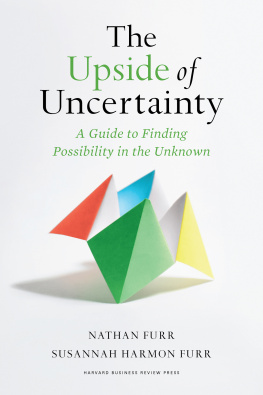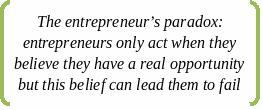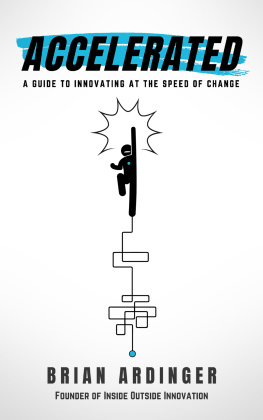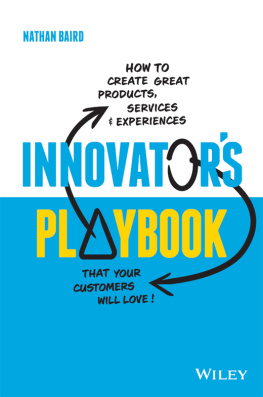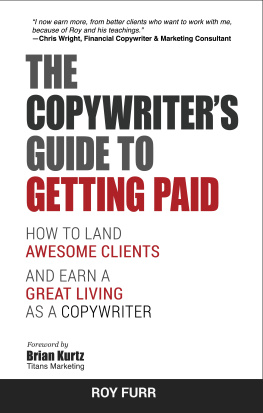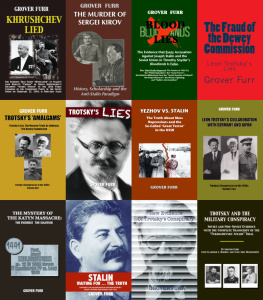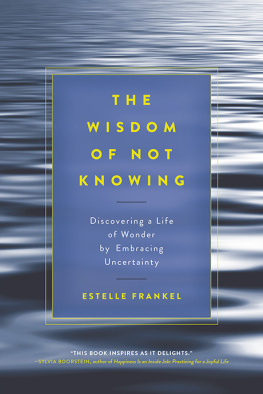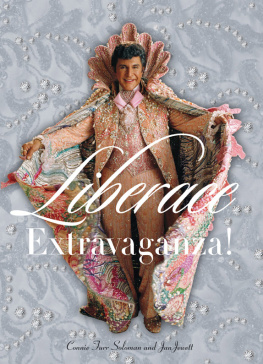Contents
Guide
About the Authors
As best friends for more than thirty years, Nathan Furr and Susannah Harmon Furr have shared a journey filled with many uncertainties. Sometimes chosen and other times not, these uncertainties have often been disorientating and filled with trepidation. Whether parenting four young kids while Nathan earned his PhD at Stanford and Susannah started a clothing line from their on-campus student housing, navigating expat life in France while simultaneously undergoing an existential faith crisis, or dealing with the stress of buying an apartment at the start of the pandemic when the majority of Nathans work suddenly disappeared, the Furrs have learned that the uncertainty implicit in each challenge has an upside. It is always a portal to possibility. Their goal is to encourage individuals to avoid backing away from uncertainty and instead to meet it boldly, with curiosity and a belief that they can navigate it well. Nathan is a professor at INSEAD, where he studies innovation and technology. He is the author of four books on innovation: Innovation Capital ; Leading Transformation ; The Innovators Method ; and Nail It Then Scale It . Susannah is an entrepreneur and designer currently creating a hope accelerator in Normandy, France.
Conclusion
Uncertainty, Courage, and Magic
I remembered that the real world was wide, and that a varied field of hopes and fears, of sensations and excitements, awaited those who had the courage to go forth into its expanse, to seek real knowledge of life amidst its perils.
Charlotte Bront
Notice in the quote above how Bront uses the word real twice: once to describe the world and once to describe knowledge. She understood that there was an artificial version of both and that we could hide in a tiny world of our own choosing, protected by artificial buffers against change, but in so doing, we would miss the real beauty of a world full of possibility.
Although reality brings challenge, discomfort, and heartache, it is the only place where innovation, solution, and evolution happen. Essayist Nassim Talebs work has explored the world of risk, volatility, and uncertainty in an effort to demonstrate that, like weightlifting, in which tearing muscles ultimately builds them, sometimes these challenges actually make things stronger and better. Talebs empowering ideathat we can strive to be more anti-fragiledefinitely shaped our thoughts about the upside of uncertainty. But his survival-of-the-fittest, stay-in-the-ring-the-longest, resilience-oriented view doesnt thrill us like the notion of transilience does.
Transilience is something beyond resilience. Resilience is being able to withstand shocks and recover. But transilience is about transformation, leaping from one state to another. It is the moment when hardened steel turns to molten metal, ordinary stone becomes smooth sculpture, and terrifying uncertainty becomes insight, wisdom, and opportunity. The framework we have shared with you is meant to encourage you to meet every uncertainty with hope, creativity, and a belief in an upside you may not yet see.
The upside of uncertainty is just as real as the downsides, but like an underdog, it just needs a fair chance to show what it can do. The upside at first can feel flimsy and tenuous: possibility? hope? transformation? Really? The downsides feel more real because they trigger fundamental warning alarms: danger, scarcity, shame, and so forth. Indeed, as venture capitalist Jerry Neumann argues, for entrepreneurs, everyone elses fear of uncertainty is a competitive advantage, the moat that protects them from competition while they create something new. But uncertainty is much greater than just a deterrent. For all of us, regardless of career or circumstance, uncertainty is arguably the portal to every growth, change, and courageous act we will ever undertake. It attends every invitation to cultivate a more meaningful, inspired, and authentic life.
So friends, remember that uncertainty will bring peril that cant be easily swept away (illness, debt, injury, trauma) and ambiguous loss that may never find complete closure. There will be mistakes, regrets, injustices, and unfairness as we navigate it. But if we try to avoid uncertainty or give up too soonor if we mistakenly decide its safest to do nothingthe downsides of uncertainty will find us anyway. Because the truest downside to uncertainty is living a life smaller than what you are capable of.
So how do we keep leaping for possibility? We suggest four critical things to remember:
- Reframe uncertainty as an essential portal to opportunity and consider all the possibilities you can imagine. Acknowledge self-doubt as a normal part of every heros journey.
- Prime yourself and the uncertainty you face with self-knowledge, research, balancers and supporters, and a collection of real options and potential exit strategies.
- Face every uncertainty based on values, cognitive flexibility, and curiosity to reveal the essence waiting to be activated and unlocked. Be prepared to take ten thousand shots, experiment, and use bricolage to bring it to life. Those arent weaknessesthats how the brightest possibilities are born.
- Sustain yourself and your projects with emotional hygiene, reality checks, and magic.
Stay curious and believe in your personal story and your ability to make it happen, even as it shifts under your feet. Ask for help and continue this light-switch leap, from downside to upside, for as long as you are alive.
We share these beliefs, not just from the comfort of the interviewers chair, but from living and applying these tools, always asking: how can we transform this uncertainty into possibility? It has not always been easy. While revising a draft of this book (our marching orders: cut it in half!), we were also neck-deep in uncertainty about how best to help one of our young adult children in the grip of severe depression. In early spring, he had confided that his Covid-related malaise had turned a corner into more debilitating feelings. While we acted quickly to find medical help and secure an official leave from art school for him, he spiraled into a psychic break while visiting our oldest child, whom he hadnt seen for eighteen months due to travel restrictions.
The harrowing journey of retrieving him in that altered and terrified manic state and bringing him back to France left us vulnerable and unprepared for things to get worse. Upon our return, his psychiatrist prescribed a battery of pills (all without our knowledge, since he is a legal adult) after which he slid into a state of excruciating numbness and despair. Riddled with a double dose of antipsychotics, a mood stabilizer, lithium, an antidepressant, and antianxiety pills, his brain was both turned off and turned on in complicated and unbearable ways. He was like a disappearing figment of himself, fading more each day, curling into the fetal position, staring at the wall. We couldnt find a local psychiatrist willing to offer a second opinion given the complexity of the prescriptions, our calls to in-patient facilities went unanswered, and a last-ditch, daylong wait in the ER ended with the physician handing Susannah a form letter announcing a yearlong wait-list. It was bleak.
We canceled our much-needed summer vacation and embarked on a very different summer: to find help for our son. That part was obvious. But managing the uncertainty would have been less obvious without the tools described here. We started by reframing the situation: we are lucky we have enough wellness ourselves to focus on this, and we have resources and a psychiatrist friend in the United States who agreed to work with us if we could get our son there. Still, the downsides of uncertainty invaded our well-being and frayed our nerves. It felt bigger than us and it made us question living abroad. We spent much of our prized runway, carefully meted out because of our decreased earnings during the Covid-19 pandemic, on a last-minute trip back to the United States.

